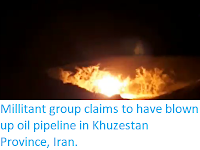At least eight people have died in a series of floods across northwestern Iran on Friday 5 and Saturday 6 October 2018, after the area suffered its heaviest rains in about 20 years, according to the Iranian Red Crescent. Four of the deaths occurred in Mazandaran Province, where three people are reported to have drowned and one died after being struck by lightning. Around 170 people have been made homeless by the floods and are staying in emergency shelters, and around 1400 more have been stranded, as the flooding has disrupted transport networks.
Northern Iran has a temperate climate with dry summers and wetter winters. Peak rainfall typically occurs in October, and flooding is often a problem when heavy rains fall after long dry periods, as dry soil tends to develop a hard crust which lowers its absorbency to water, and low ground absorbency leads to large amounts of water at the surface, typically moving downhill at some speed.
See also...
A road washed away by flooding in the city of Tonekabon in Mazandaran Province, Iran, on 6 October 2018. Ahmad Halabisaz/Xinhua.
Northern Iran has a temperate climate with dry summers and wetter winters. Peak rainfall typically occurs in October, and flooding is often a problem when heavy rains fall after long dry periods, as dry soil tends to develop a hard crust which lowers its absorbency to water, and low ground absorbency leads to large amounts of water at the surface, typically moving downhill at some speed.
See also...
Follow Sciency Thoughts on Facebook.







